Research Article
Radiological Features of the Brain and Spinal Cord Gliomas on Computed Tomography and Magnetic Resonance Imaging
| Sultan Alshoabi1,2, Moawia Gameraddin1* and JumaaTamboul1 | |
| 1Department of Diagnostic Radiologic Technology, Faculty of Applied Medical Sciences, Taibah University, Almadinah Almunawarah, Saudi Arabia | |
| 2Al-Thawra Modern General Hospital (TMGH), Republic of Yemen | |
| Corresponding Author : | Moawia Gameraddin Department of Diagnostic Radiologic Technology Faculty of Applied Medical Sciences Taibah University, Almadinah Almunawarah Saudi Arabia Tel: + 00966534821130 E-mail: m.bushra@yahoo.com |
| Received: November 06, 2015 Accepted: December 23, 2015 Published: December 28, 2015 | |
| Citation: Alshoabi S, Gameraddin M, Tamboul J (2015) Radiological Features of the Brain and Spinal Cord Gliomas on Computed Tomography and Magnetic Resonance Imaging. OMICS J Radiol 4:211. doi:10.4172/2167-7964.1000211 | |
| Copyright: © 2015 Alshoabi S, et al. This is an open-access article distributed under the terms of the Creative Commons Attribution License, which permits unrestricted use, distribution, and reproduction in any medium, provided the original author and source are credited. | |
Abstract
Aim: The aim of this study is to characterize the site, types and radiological features of gliomas, such as edema, mass effect, and type of enhancement on CT-scan and MRI imaging.
Patients and methods: Thirty-three patients were studied retrospectively from the PACS system of multi-slice CT-scanner and MRI using the protocol of imaging of the head and spine.
Results: Gliomas involved male patients more than females (60.1% vs. 39.9%). About 96.9% of the gliomas were in the brain and only 3.1% was in the cervical spine. Nearly 51.5% of the gliomas showed radiographic features of low-grade gliomas and 48.5% showed radiographic features of high-grade gliomas. Approximately 30% of gliomas were located at the parietal lobe of the brain. Nearly 45.5% of the gliomas showed heterogenous enhancement, 36.4% marginal enhancement and 5.1% had no enhancement after contrast administration.
Conclusion: Gliomas were more common in male than female and high grade in elderly while low-grade gliomas in children. Gliomas were mostly involving the parietal lobes. The majority of gliomas showed heterogeneous enhancement after contrast administration. Magnetic resonance imaging is the most effective imaging method to characterize gliomas.

 Spanish
Spanish  Chinese
Chinese  Russian
Russian  German
German  French
French  Japanese
Japanese  Portuguese
Portuguese  Hindi
Hindi 
